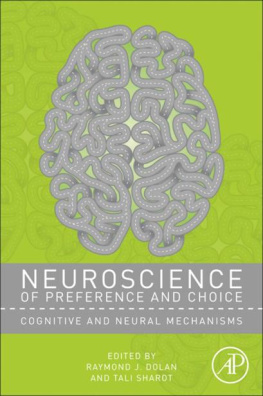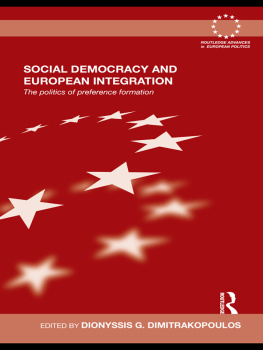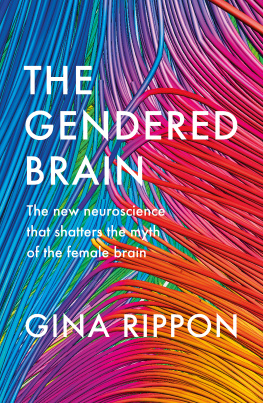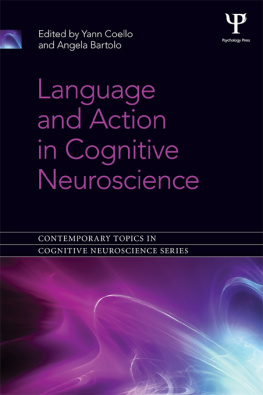Table of Contents
Front-matter
Neuroscience of Preference and Choice
NEUROSCIENCE OF PREFERENCE AND CHOICE
COGNITIVE AND NEURAL MECHANISMS
Edited by
R aymond D olan Wellcome Trust Centre for Neuroimaging University College London London, UK
T ali S harot Wellcome Trust Centre for Neuroimaging University College London London, UK

AMSTERDAM BOSTON HEIDELBERG LONDON NEW YORK OXFORD PARIS SAN DIEGO SAN FRANCISCO SINGAPORE SYDNEY TOKYO

Academic Press is an imprint of Elsevier
Copyright
Academic Press is an imprint of Elsevier
32 Jamestown Road, London NW1 7BY, UK
225 Wyman Street, Waltham, MA 02451, USA
525 B Street, Suite 1800, San Diego, CA 92101-4495, USA
First edition 2012
Copyright 2012 Elsevier Inc. All rights reserved
No part of this publication may be reproduced, stored in a retrieval system or transmitted in any form or by any means electronic, mechanical, photocopying, recording or otherwise without the prior written permission of the publisher Permissions may be sought directly from Elseviers Science & Technology Rights Department in Oxford, UK: phone (+44) (0) 1865 843830; fax (+44) (0) 1865 853333; email: for further information
Notice
No responsibility is assumed by the publisher for any injury and/or damage to persons or property as a matter of products liability, negligence or otherwise, or from any use or operation of any methods, products, instructions or ideas contained in the material herein. Because of rapid advances in the medical sciences, in particular, independent verifi cation of diagnoses and drug dosages should be made
British Library Cataloguing-in-Publication Data
A catalogue record for this book is available from the British Library
Library of Congress Cataloging-in-Publication Data
A catalog record for this book is available from the Library of Congress
ISBN: 978-0-12-381431-9
For information on all Academic Press publications visit our website at: www.elsevierdirect.com
Typeset by MPS Limited, a Macmillan Company Chennai, India www.macmillansolutions.com
Printed and bound in United States of America
12 13 14 15 16 10 9 8 7 6 5 4 3 2 1
Preface
Ray Dolan and Tali Sharot
Wellcome Trust Centre for Neuroimaging, Institute of Neurology, University College London
How preferences are generated, and choices made, is the central focus of this book. Mindful that preferences is a subject of broad interest we asked the contributing authors to detail diverse approaches, appropriate to their core expertise ranging from evolutionary biology to social psychology, psychophysics, cognitive neuroscience and economics. The contributions explore the neural and psychological processes that underlie decision-making, propose formal models of the associated mechanisms and illustrate their application to domains that include perception, social interaction and policy.
We see these various contributions as supporting two general claims. First, they argue that contrary to traditional decision-making theories, which assume choices are based on relatively steady preferences, preferences are in fact highly volatile and susceptible to the context in which the alternatives are presented. For example, the same object seems to be worth more if we are engaged in selling as opposed to buying it. Moreover, our preferences are modified by the mere act of choosing and altered by changing choice sets.
The observation that preferences are fluid invokes the idea that fluidity is embedded in the architecture of our brain. Part II of this book, in particular, is dedicated to this theme. Data from different scientific modalities, going from single cell recordings in non-human primates right through to brain imaging data in human adults, supports the notion that preferences are unstable and easily altered by context. One might assume that this instability in preferences is generated by an abundance or tyranny of choice in modern society. After all, unlike our ancestors, we can select from a near-infinite number of possibilities on where to live, who to marry, which profession to embark upon and how to spend our leisure time. However, by comparing valuation processes across non-human primates, human children, and human adults, Lakshminarayanan and Santos show that there are evolutionary conserved constraints on our preferences. Thus, like adults, children and non-human primates change their preferences based on the context in which the options are presented. Like humans, primates show loss aversion, post-choice re-evaluation, and the endowment effect.
The second theme to emerge is the commonality of the processes underlying preference generation. We suggest that regardless of whether we are selecting a musical tune, a perfume, or a new car the brain uses similar computational principles to compute the value of our options, which are tracked by common neural systems. Part I of this book describes these systems and offers possible models for how decisions are taken. Part III then asks how these processes underlie social preferences and Part IV focuses on the perceptual processes that underlie preference generation.
The book concludes with a discussion of the implications of the research presented to policy, health and well-being. It highlights the societal importance of how understanding the neuroscience of preference and choice might help us make better decisions in our personal life and aid policy makers in enhancing the well-being of citizens.
Contributors
Andrew Caplin
Professor of Economics and Co-Director of the Center for Experimental Social Science, New York University
Daniel Campbell-Meiklejohn
Center for Functionally Integrative Neuroscience, Aarhus University and Wellcome Centre for Neuroimaging at University College London
Nick Chater
Behavioural Science Group, Warwick Business School, University of Warwick
Graldine Coppin
Swiss Center for Affective Sciences, and Laboratory for the Study of Emotion Elicitation and Expression, University of Geneva
Ara Darzi
Division of Surgery, Imperial College London, London
Peter Dayan
Gatsby Computational Neuroscience Unit, UCL, London, UK
Raymond J. Dolan
Wellcome Trust Centre for Neuroimaging, Institute of Neurology University College London, London
Chris D. Frith
Center for Functionally Integrative Neuroscience, Aarhus University and Wellcome Centre for Neuroimaging at University College London
Paul W. Glimcher
Center for Neural Science, New York University
Lars Hall
Lund University Cognitive Science, Lund University
Petter Johansson
Division of Psychology and Language Sciences, University College London












 AMSTERDAM BOSTON HEIDELBERG LONDON NEW YORK OXFORD PARIS SAN DIEGO SAN FRANCISCO SINGAPORE SYDNEY TOKYO
AMSTERDAM BOSTON HEIDELBERG LONDON NEW YORK OXFORD PARIS SAN DIEGO SAN FRANCISCO SINGAPORE SYDNEY TOKYO 
